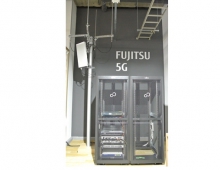
Fujitsu Develops 3D Gesture Recognition Technology
Fujitsu Laboratories and Fujitsu Research and Development Center Co., Ltd. of China have develeped a 3D hand gesture recognition technology capable of complex tasks with a single PC or tablet camera.
The technology uses video captured on a single PC or tablet camera to detect not only vertical and horizontal hand motion, but also the forward and backward movements of increasing or decreasing distance of a hand from the display.
With existing hand gesture recognition technology it has been possible to detect hand motions along the vertical and horizontal axes, which represent operations similar to moving a mouse cursor. However, detecting forward and backward hand motions - changing distance to perform the same function as a mouse click - has proven difficult. Fujitsu Laboratories and Fujitsu R&D Center have developed technology for accurately detecting the area of a hand based on models of palms, as well as a technology that detects forward and backward hand motions. This has made it possible for users to perform click operations through "push" gestures.
The new technology makes it possible to use hand gestures to perform a host of complex operations. For instance, a user can wave his or her hand up and down to make a menu selection on a PC and then confirm the selection with a "push" gesture, even from a distance. Maps and other images can also be expanded or shrunk with "push" and "pull" gestures.
How it works
The hand is initially detected in a captured image, from which it is clipped out using block units of set sizes. Calculations are then made to determine whether or not the hand's characteristics (a palm model) exist as pre-registered data. The actual position and size of the hand is determined by performing this operation against the backdrop of the overall image while changing the position and size of the blocks. Next, the hand's area is extracted by taking the determined hand position and size and simultaneously changing the color threshold of certain parts to express the hand's original image. These operations ensure stable detection of the hand area.
The technology is able to accurately estimate depth based on the continuity of the user's hand motions, including constantly changing features such as hand size, angle and central location. This allows "push" and "pull" motions to be detected with roughly 90% accuracy.
There are many potential applications of the new technology. For instance, a user can wave his or her hand up and down to make a menu selection on a device and then confirm the selection with a "push" gesture. Movies, music, sports, and other kinds of content can be selected by waving a hand left and right, and then confirmed with a "push" gesture. Maps and other images can also be expanded or shrunk with a "push" or "pull," thereby making possible even more complex operations via hand gestures. In addition, since motion can be detected with a single camera, equipment can be produced at a low cost.
Fujitsu aims at commercialization of the technology in fiscal 2014.
With existing hand gesture recognition technology it has been possible to detect hand motions along the vertical and horizontal axes, which represent operations similar to moving a mouse cursor. However, detecting forward and backward hand motions - changing distance to perform the same function as a mouse click - has proven difficult. Fujitsu Laboratories and Fujitsu R&D Center have developed technology for accurately detecting the area of a hand based on models of palms, as well as a technology that detects forward and backward hand motions. This has made it possible for users to perform click operations through "push" gestures.
The new technology makes it possible to use hand gestures to perform a host of complex operations. For instance, a user can wave his or her hand up and down to make a menu selection on a PC and then confirm the selection with a "push" gesture, even from a distance. Maps and other images can also be expanded or shrunk with "push" and "pull" gestures.
How it works
The hand is initially detected in a captured image, from which it is clipped out using block units of set sizes. Calculations are then made to determine whether or not the hand's characteristics (a palm model) exist as pre-registered data. The actual position and size of the hand is determined by performing this operation against the backdrop of the overall image while changing the position and size of the blocks. Next, the hand's area is extracted by taking the determined hand position and size and simultaneously changing the color threshold of certain parts to express the hand's original image. These operations ensure stable detection of the hand area.
The technology is able to accurately estimate depth based on the continuity of the user's hand motions, including constantly changing features such as hand size, angle and central location. This allows "push" and "pull" motions to be detected with roughly 90% accuracy.
There are many potential applications of the new technology. For instance, a user can wave his or her hand up and down to make a menu selection on a device and then confirm the selection with a "push" gesture. Movies, music, sports, and other kinds of content can be selected by waving a hand left and right, and then confirmed with a "push" gesture. Maps and other images can also be expanded or shrunk with a "push" or "pull," thereby making possible even more complex operations via hand gestures. In addition, since motion can be detected with a single camera, equipment can be produced at a low cost.
Fujitsu aims at commercialization of the technology in fiscal 2014.





















